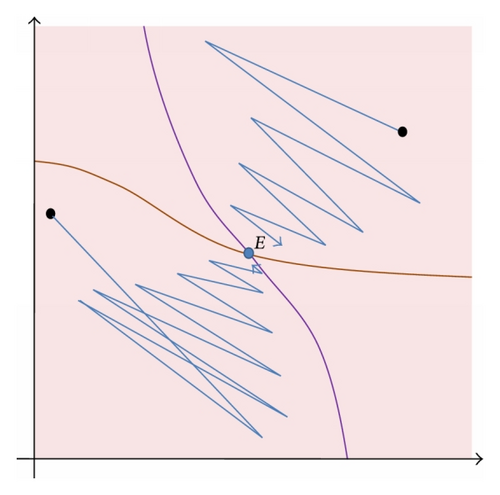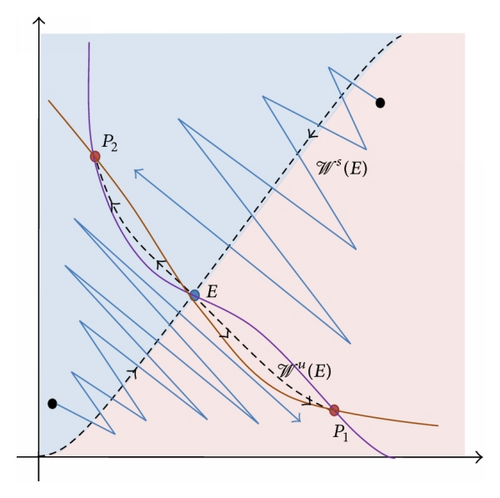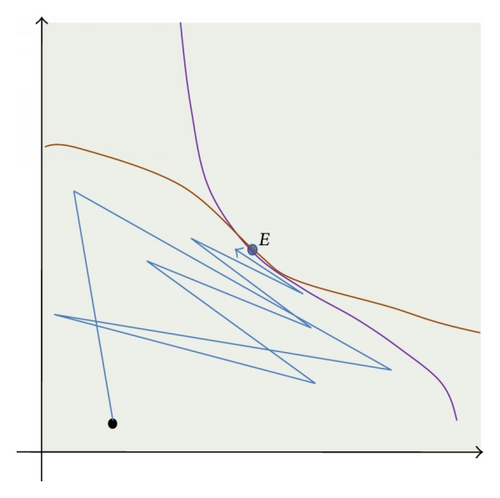Global Period-Doubling Bifurcation of Quadratic Fractional Second Order Difference Equation
Abstract
We investigate the local stability and the global asymptotic stability of the difference equation , n = 0,1, … with nonnegative parameters and initial conditions such that , for all n ≥ 0. We obtain the local stability of the equilibrium for all values of parameters and give some global asymptotic stability results for some values of the parameters. We also obtain global dynamics in the special case, where β = B = 0, in which case we show that such equation exhibits a global period doubling bifurcation.
1. Introduction
First systematic study of global dynamics of a special quadratic fractional case of (3) where A = C = D = a = c = d = 0 was performed in [2, 3]. Dynamics of some related quadratic fractional difference equations was considered in the papers [6–9]. In this paper, we will perform the local stability analysis of the unique equilibrium which is quite elaborate and we will give the necessary and sufficient conditions for the equilibrium to be locally asymptotically stable, a saddle point, or a nonhyperbolic equilibrium. The local stability analysis indicates that some possible dynamics scenarios for (1) include period-doubling bifurcations and global attractivity of the equilibrium. Another possible scenario includes global periodicity; that is, the possibility that all solutions are periodic of the same period. This means that the techniques we used in [5, 6, 10–14] are applicable. We will also obtain the global asymptotic stability results for (1). As we have seen in [1], an efficient way of studying the dynamics of (1) is considering the dynamics of 49 special cases of (1) which are obtained when one or more coefficients are set to be zero. It is interesting to notice that sometimes the most complex dynamics can be one of the very special cases of general equation, see [1]. Based on our results in [1], it is difficult to prove global asymptotic stability results of the unique equilibrium even for linear fractional difference equations where there are still two remaining cases needed to prove the general conjecture that local stability of the unique equilibrium implies the global stability. This task is even more challenging in the case of quadratic fractional difference equation such as (3).
- (1)
Beverton-Holt difference equation, when α = γ = A = 0:
() -
which represents the basic discrete model in population dynamics; see [15].
- (2)
Riccati difference equation, when α = A = 0:
() - (3)
Difference equation studied in [1, 4, 16], when γ = C = 0:
() -
which represents the discretization of the differential equation model in biochemical networks; see [17].
2. Preliminaries
The global attractivity results obtained specifically for complicated cases of (3) are the following theorems [18].
Theorem 1. Assume that (3) has the unique equilibrium . If the following condition holds:
Theorem 2. Assume that (3) has the unique equilibrium , where and are lower and upper bounds of specific solution of (3) and m + f > 0. If the following condition holds:
In the case of (1), Theorems 1 and 2 give the following special results.
Corollary 3. If the following condition holds:
Corollary 4. If the following condition holds:
Corollary 3 can be used efficiently to obtain global stability results for the special cases of (1), in particular, for some equations of types (2,2), (3,2), and (3,3), where type (k, m) means that special case of (1) has k terms in the numerator and m terms in the denominator. See Section 4.
In this paper, we present the local stability analysis for the unique equilibrium of (1) and then we apply Corollaries 3 and 4 to some special cases of (1) to obtain global asymptotic stability results for those equations. The obtained results will give the regions of parametric space where the unique positive equilibrium of (1) is globally asymptotically stable. In the coming manuscript we will give more precise dynamics in some special cases of (1) such as the case where α = β = 0, where the theory of monotone maps will give the global dynamics.
Theorem 5. Let I be a set of real numbers and let f : I × I → I be a function which is nonincreasing in the first variable and nondecreasing in the second variable. Then, for every solution of the equation
- (i)
eventually, they are both monotonically increasing;
- (ii)
eventually, they are both monotonically decreasing;
- (iii)
one of them is monotonically increasing and the other is monotonically decreasing.
The consequence of Theorem 5 is that every bounded solution of (14) converges to either equilibrium or period-two solution or to the point on the boundary, and the most important question becomes determining the basins of attraction of these solutions as well as the unbounded solutions.
The next result is the global period-doubling bifurcation result from [5] which also gives precise description of the basins of attraction of equilibrium points and periodic solutions of the considered equation.
Theorem 6. Let 𝒜 be a connected subset of ℝk, and, for each α ∈ 𝒜, let ℐα⊂ℝ be an interval. Let Γ:𝒜 → ℝ be a continuous function. Consider a family of difference equations
with fα(x, y) being continuous on ℛα : = ℐα × ℐα, for α ∈ 𝒜. Suppose that, for each α ∈ 𝒜, the following statements are true.
- (a1)
, and fα(x, y) is strictly decreasing in x and strictly increasing in y in .
- (a2)
There exists a family of isolated equilibria that vary continuously in α.
- (a3)
fα(x, y) is continuously differentiable on a neighborhood of , with partial derivatives D1fα and D2fα being continuous in α.
- (a4)
Let ηα and να be the roots of the characteristic equation of (15) at xα, ordered so that |ηα | ≤|να|:
-
(i) if Γ(α) < 0, then −1 < να < 0 < ηα < 1,
-
(ii) if Γ(α) = 0, then −1 = να < 0 < ηα < 1,
-
(iii) if Γ(α) > 0, then να < −1 < 0 < ηα < 1.
-
- (a5)
If Γ(α) < 0, xα is the unique equilibrium of (15) in ℐα and there are no prime period-two solutions in the rectangle of initial conditions ℐα × ℐα. If Γ(α) > 0, there exist no prime period-two solutions in the region of initial conditions , where Q1(a, a) (resp., Q3(a, a)) denotes the first (resp., third) quadrant with respect to the point (a, a).
- (a6)
For Γ(α) < 0, statement A7 of Theorem 4.1 in [12] is true for the map defined on ℛα, where Fα(u, v) = (v, fα(v, u)).
Then the following statements are true.
- (i)
For α such that Γ(α) < 0, the equilibrium is a global attractor on ℛα.
- (ii)
For α such that Γ(α) > 0, the stable set of the equilibrium is a curve in ℐα × ℐα which is the graph of a continuous and increasing function that passes through and that has endpoints in ∂(ℐα × ℐα). Furthermore,
-
(ii.1) if ℛα is compact or if there exists a compact set 𝒦 ⊂ ℐα such that f(ℐα × ℐα) ⊂ 𝒦, then there exist prime period-two solutions (ϕ, ψ) and (ψ, ϕ);
-
(ii.2) if prime period two solutions (ϕ, ψ) and (ψ, ϕ) exist in and , respectively, and if they are the only prime period-two solutions there, then every solution {xn} with initial condition in the complement of the stable set of the equilibrium is attracted to one of the period-two solutions; that is, whenever , either x2n → ϕ and x2n+1 → ψ or x2n → ψ and x2n+1 → ϕ;
-
(ii.3) if there are no prime period-two solutions, then every solution {xn} of equation xn+1 = fα(xn, xn−1), n = 0,1, … with initial condition in 𝒲− is such that the subsequence {x2n} eventually leaves any given compact subset of ℐα, and every solution {xn} of xn+1 = fα(xn, xn−1), n = 0,1, … with initial condition in 𝒲+ is such that the subsequence {x2n+1} eventually leaves any given compact subset of ℐα.
-
3. Linearized Stability Analysis
In this section we present the local stability of the unique positive equilibrium of (1).
3.1. Equilibrium Points
In summary, it is interesting to observe that when (1) has a positive equilibrium , then is unique and satisfies (17). This observation simplifies the investigation of the local stability of the positive equilibrium of (1).
3.2. Local Stability of the Positive Equilibrium
Theorem 7. Assume that
- (i)
locally asymptotically stable, if A(3C + α) + B(C + 3α + β) > βA;
- (ii)
a saddle point, if A(3C + α) + B(C + 3α + β) < βA;
- (iii)
a nonhyperbolic point, if A(3C + α) + B(C + 3α + β) = βA or (β = 0, A = 0, B > 0, α > 0).
Proof. It is easy to see that
Theorem 8. Assume that
Proof. A straightforward calculation gives
Lemma 9. Let p and q be the partial derivatives given by (38) and (39). Assume that
Proof. The inequality 1 − p − q > 0 is equivalent to
Lemma 10. Let p and q be partial derivatives given by (38) and (39). Assume that
Proof.
- (i)
Let A = 0, then, from (40), p − q + 1 > 0.
- (ii)
Assume that B(C + 3α + β) + A(C + α − β) > 0 and A > 0. Then p − q + 1 > 0 is equivalent to . One can see that
() -
if and only if
() -
since
() -
In view of (42), we have that p − q + 1 > 0, if and only if
() -
which is equivalent to
() -
in view of
()() -
The conditions in (57) are equivalent to
() -
and from which the proof follows.
- (iii)
Assume that B(C + 3α + β) + A(C + α − β) < 0 and A > 0. Then p − q + 1 > 0 is equivalent to . It is easy to see that
() -
if and only if
() -
which implies that p − q + 1 > 0, if and only if
() -
which is equivalent to
() -
since
() -
Since
() -
we have that (64) is equivalent to
() -
and from which the proof follows.
- (iv)
If B(C + 3α + β) + A(C + α − β) = 0 and A > 0, then it is enough to see that
()
-
which is equivalent in this case to
()
Lemma 11. Let q be the partial derivative given by (39). Assume that
Proof. Inequality q > −1 is equivalent to
Let C < α.
Relation (71) is equivalent to
So, q + 1 > 0 holds for all values of parameters.
Thus, we proved the following result.
Theorem 12. Assume that
- (i)
a locally asymptotically stable point, if and only if any of the following holds:
-
(a)
() -
(b)
()
-
- (ii)
a saddle point, if and only if the following holds:
() - (iii)
a nonhyperbolic point, if and only if the following holds:
()
4. Global Asymptotic Stability Results
In this section we give the following global asymptotic stability result for some special cases of (1).
Theorem 13. (i) Consider (1), where C = 0 and all other coefficients are positive, subject to the condition
(ii) Consider (1), where all coefficients are positive, subject to the condition (1) where L = min{α, β, γ}/max{A, B, C} and U = max{α, β, γ}/min{A, B, C}. Then is globally asymptotically stable.
Proof. In view of Corollary 3, we need to find the lower and upper bounds for all solutions of (1), for n ≥ 1.
A consequence of Theorem 13 is the following result.
Corollary 14. Consider (1), where A = C = 0 and all other coefficients are positive, subject to the condition
By using similar method as in the proof of Theorem 13, one can prove the following result.
Theorem 15. Consider (1), where B = β = 0 and all other coefficients are positive, subject to the condition
Proof. Now, we have
Remark 16. Equation (1), where C = γ = 0 and all other coefficients are positive reduces to well-known equation (7) which was studied in great details in [1, 4] and for which we have shown that the unique equilibrium is globally asymptotically stable, if and only if it is locally asymptotically stable; that is, if and only if the condition (i) of Theorem 7 holds. This result is certainly better than the global asymptotic result we derive from Corollaries 3 and 4. However, the results where local stability implies global stability are very rare and it seems to be limited only to second order linear fractional difference equations; see [16, 19].
Remark 17. Equation (1), where either A = 0 or B = 0 and all other coefficients are positive can be treated with Corollary 4 and global asymptotic stability of the equilibrium (whenever it exists) follows from condition (12) in the interval when , that is, when x−1x0 > 0. Similarly, (1), where exactly one of the coefficients α, β, or γ is zero, and all other coefficients are positive can be treated with Corollary 4 and global asymptotic stability of the equilibrium follows from condition (12) in the interval when , that is, when x−1x0 > 0. In this case can be replaced by U = max{α, β, γ}/min{A, B, C}.
5. Equation
In this section we present the global dynamics of (8), which exhibits a global period-doubling bifurcation introduced in [5].
5.1. Local Stability Analysis
Theorem 18. The unique positive equilibrium point of (90) is
- (i)
locally asymptotically stable, when
() - (ii)
a saddle point, when
() - (iii)
a nonhyperbolic point, when
()
Lemma 19. If
Proof. Assume that {(ϕ, ψ), (ψ, ϕ)} is a minimal period-two solution of (90). Then
From (105) and (106), we obtain the system
We obtain that solutions (x±, y±) of system (109) are
5.2. Global Results and Basins of Attraction
In this section, we present global dynamics results for (90), in case C < γ.
Lemma 20. Every solution of (90) is bounded from above and from below by positive constants.
Proof. Indeed
Theorem 21. The following statements are true.
- (i)
If C < γ < (1/4)(3 + 10C + 3C2), then (90) has a unique equilibrium point , which is locally asymptotically stable and has no minimal period-two solution. Furthermore, the unique positive equilibrium point
() -
is globally asymptotically stable.
- (ii)
If γ > (1/4)(3 + 10C + 3C2), then (90) has a unique equilibrium point which is a saddle point and has the minimal period-two solution {P(ϕ, ψ), Q(ψ, ϕ)}. Global stable manifold 𝒲s(E), which is continuous increasing curve, divides the first quadrant such that the following holds:
-
(ii1) every initial point (u0, v0) in 𝒲s(E) is attracted to E;
-
(ii2) if (u0, v0) ∈ 𝒲+(E) (the region below 𝒲s(E)), then the subsequence of even-indexed terms {(u2n, v2n)} is attracted to Q and the subsequence of odd-indexed terms {(u2n+1, v2n+1)} is attracted to P;
-
(ii3) if (u0, v0) ∈ 𝒲−(E) (the region above 𝒲s(E)), then the subsequence of even-indexed terms {(u2n, v2n)} is attracted to P and the subsequence of odd-indexed terms {(u2n+1, v2n+1)} is attracted to Q.
-
- (iii)
If γ = (1/4)(3 + 10C + 3C2), then (90) has a unique equilibrium point which is nonhyperbolic and has no minimal period-two solution. The equilibrium point is a global attractor.
Proof. Let
- (i)
If C < γ < (1/4)(3 + 10C + 3C2), then appropriate function of (90) is nonincreasing in the first variable and nondecreasing in the second variable. From Theorem 18, (90) has a unique equilibrium point , which is locally asymptotically stable and, from Lemma 19, (90) has no minimal period-two solution. All conditions of Theorem 6 are satisfied from which follows that a unique equilibrium point is a global attractor. So, is globally asymptotically stable.
- (ii)
From Theorem 18, (90) has a unique equilibrium point , which is a saddle point. From Lemma 19, (90) has a unique minimal period-two solution {P(ϕ, ψ), Q(ψ, ϕ)}. The map T = T(x, y) = (y, f(y, x)) has neither fixed points nor periodic points of minimal period-two in . All conditions of Theorem 6 are satisfied from which follows that every solution {xn} with initial condition in the complement of the stable set of the equilibrium is attracted to one of the period-two solutions. That is, whenever , either x2n → ϕ and x2n+1 → ψ or x2n → ψ and x2n+1 → ϕ. It is not hard to see that the map T is anticompetitive (which means that T2 is competitive) and T2 is strongly competitive from which we have that conclusions (ii1), (ii2), and (ii3) hold.
- (iii)
For graphical illustration of Theorem 21, see Figure 1.



Based on our simulations, we pose the following conjecture.
Conjecture 22. The equilibrium of (90) is globally asymptotically stable for γ < C.
Conflict of Interests
The authors declare that there is no conflict of interests regarding the publication of this paper.
Acknowledgment
The authors are grateful to the anonymous referee for number of suggestions that have improved the quality of exposition of the results.




